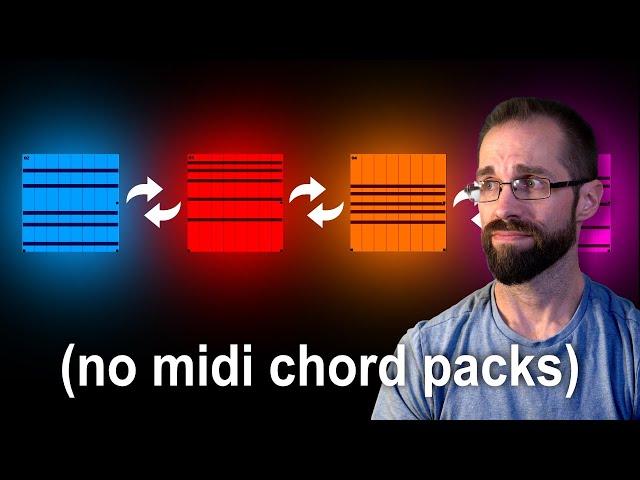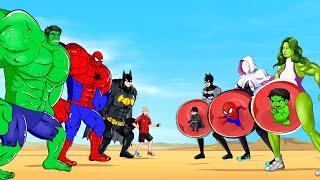
How to actually WRITE great progressions (in 8 minutes)
Комментарии:

There is rules for breaking the rules. On some level the progression have to make sense. If the highest notes of the chords create some melody that makes sense it sounds more coherent. If there is no distinctive melody line it sounds like random stuff. The normies like something that sounds intentional.
Ответить
This is a semi-joke idea, but the chord progression could possibly be named as I - DDalt (secondary dominant with sharp VII) - V - SS (double subdominant, or maybe as a chromatic mediant of the V) - IIb (again, a possible chromatic mediant, which if later solved back into the I again would create a tritone sub, tying the whole "progression into a "cycle". But that's silly. But possible.)
Ответить
Can we discuss "cyclic" for a moment because much music repeats patterns? In the video you discuss not repeating a chord, or at least trying hard not to. Your videos have been great teaching me about non-loop progression - very helpful. But I would say most of my music is Cyclic :P Thank you.
Ответить
I'm happy that guy sent in that question, but I feel you could delve more into it. How exactly did you arrive at those chords?
Ответить
Yo dawg this is some fresh ass stuff
Ответить
Why are U using this old muddy synth to explain stuff like that. It sounds like under the floorboard of another room.
U don't have a proper DX7? With clarity? Jump on the bandwagon of DIGITAL. U will never look back.

The new AI chord generator in FL studio is pretty amazing. I've already centered two songs around it's results... But the best thing about it is that I'm learning how to write my own progressions better. The generator has lots of options for chord voicings, etc and it also feels like a teaching tool for someone like me who is still learning theory
Ответить
Probably the biggest reason i turned to theory more seriously was to find a way out of diatonic chords. The key to me has been learning about the kinds of transitions/substitutions that work in given situations (work as in, satisfy my own harmonic sense of interest/enjoyment, which obviously everyone has a different idea of)
Ответить
I love your content! I do however now hesitate to get your harmony course. Here's why. My knowledge and skill level is pretty low still currently. With theory, I'm an advanced beginner. I understand the concepts and how things relate to each other at least in the conceptual level while not necessarily being able to fluently utilize that knowledge to actually produce "good" music due to also other skills still missing.
However, what I do know is that all the future music that I will be creating will follow functional harmony quite a bit. Still, I am open to new ideas if they help me get better. I just have a really hard time seeing how non-functional harmony or 12-tone music will help me make better music as all the examples given here and elsewhere just simply sound too dissonant and chaotic to me and something I'd brush off as a mistake if I did them (unless it's for a aleatoric horror film track or to sepcifically create a confused or a really unstable mood).
That being said, I understand that I might be missing something crucial here. So, with that background, how will the course help me produce better music that remains - mainly - in the realm of functional harmony? Can you help me in my quest to understand this to make an informed decision?

In a way, there's no such thing as non-functional harmony. If you've listened to enough music, your hearing is conditioned to "make sense" out of things. A good example of this - create "chord clouds" of random note clusters...keep it sustained and then try to noodle over that. For a lot of musicians your ear will find some logical way to assimilate that sonority. So if I heard a Db going to C, it probably sounds like a tri-tone substitution cadence to me. Even though they're not related harmonically.
Ответить
So how well does this great progression go over with Vocalist? 🤔
Ответить
Isn't repetitive simple functional harmony works best for most people who listen to music? That's why it's called harmony :) non functional is not even a harmony, it's a bunch of intervals thrown together to make it sound different, experimental or more "interesting". But usually it sounds a bit weird and it might occasionally satisfy our curiosity. However, in a field of popular music if you'd like to appeal to more people than a few academic researchers you might find yourself working around your old functional harmony rules.
Ответить
Nonfunctional is just a fancy word for "doesn't work". The only thing that slightly redeems these chords is playing them on a Prophet.
Ответить
Brilliant. Lots of fun ways to play with this idea in Bitwig. P.S. I hope you’ve listened to Dave Tipper’s music.
Ответить
Great video! I will have to play around with this. I'm curious if anyone has examples of "top 100 rock" tunes that use non-functional harmony (yeah, I'm a shallow musical person). A bit of googling suggests to me that perhaps a lot of jazz (e.g., Chick Corea) uses non-functional chord progressions. I might be using incorrect search terms, but I'm not finding "pop music" examples. Radiohead was mentioned in one post as an example; although I am not musical enough to understand their music or even be able to figure what chords are being used (refer back to my previous comment about my lack of musical sophistication).
Ответить
Having heard, just the other niight, the mighty Turangalila Synphony played by the BBC Philharmonic Orchestra, live in the Royal Albert Hall as part of the BBC Prom season, my mind is wide open to complex harmony and advanced rhythmical structures. A great favourite and rarely performed for many good reasons.
For all my appreciation of these rich and exciting sounds, I am still deeply conditioned to make music around a tonal centre. I think what you've done here is very helpful but I would be the one looking (bumbling) around for a "comfortable" transition and using the scrunchier intervals sparingly. I think EDM can sometimes go wild and sometimes bootless into what I think of as "experimental" harmony as long as, while so doing, it retains a powerful rhythmic propulsion. The poignancy and piquancy of stabbing and jarring voices can be very effective in a minimal dance landscape. Likewise, I feel that advanced rhythmic elements work out more successfully when the harmonic element or the sound texture is offering a continuity to bring the listener through.
The landscape of "Ambient" music has become incredibly bland by virtue of an overly saccharine tonal structure (present company excepted of course). The problem being, as I see it, is the purveyance of a musical "Chill" therapy for those so wired by contemporary life they need a relaxation tape. That's not what Music for airports was about.

"snowman looking chords" 😅
Ответить
Thanks
Ответить
Crazy idea! Music equipment vendors have been promoting “you don’t need to play an instrument” to non-musicians to expand sales. Just buy our cool device! Meanwhile midi generators like Scaler, Captian Epic, Ripchord, etc. ….and midi chord packs promise “hit songs”. The idea of non-musicians creating hit songs fits societies desire to get rich and famous without any effort. I don’t see that changing any time soon.
Ответить
Loved this! A great antithesis to all the 'get rich quick' schemes all over music YT
Ответить
MIDI chord packs are just kinda... sad. Even if you're a noob to music theory, even if you're not a piano performer, creating your own chords, even if they're basic functional triads, and whether you play them live or program them in with a mouse, is sort of the BARE MINIMUM to say that you're actually "composing" music, as opposed to just slapping together pre-made bits that your don't understand and seeing if it sounds "ok" or not.
Ответить
How much money do you think I could get from selling this chord progression?
C Am F G

So I can achieve the "extended snowman" by setting my keystep 37 to "chords" and stacking 5 notes. As I've never attended music university, I can then just hit any key and achieve non-functional chord progressions by ... not giving a sh!t about music theory? That's amazing! 😂
Ответить
"The Rule" 🤣 everything in music theory was thought up to help ppl more quickly and repeatably construct musical ideas that sound good without needing to just fumble around aimlessly trying to land on something good, and also as a way to communicate to others how to perform music as a cohesive entity efficiently, there's no hard and fast rules within music theory as there is with physics or math.
Ответить
Great video, as usual.
If I may suggest one thing: in these "more theoretical" videos, I'd prefer a simpler sound to showcase the examples (the chord progression, in this case). Reason being... that evolving pad sounds nice and all, but if you stack 5 notes it's a bit "messy" to listen to. You mentioned it in many of your videos: a good foundation for your music should sound good also on a piano.
Unless you did it to show off your Prophet, in which case I totally understand. :P
Thanks again for the vid and all your content, you're the best creator on YT when it comes to these topics, by a far margin.

If these chords are not random, how were they chosen?
Ответить
Love it. Great concept!
Ответить
This is all great and informative … but where do I buy your midi chord pack!? 😂
Ответить
Amazing video! Thank you!
Ответить
something i got really hung up one was funtional harmony/chord progressions. Im still a novice but it sorta helped me stop overthinking things when i stopped feeling like there was a way things were "supposed" to go sort of. i dunno if that makes sense but i hope it helps someone
Ответить
Basically what you say, and you said it once or twice, is do not repeat the same chord. I guess you re right, the word progression gets its meaning. Thanks man, much appreciated
Ответить
Between you, Jordan, Carr & Jorb...I've got my electronica covered.
Ответить
The glorious irony of having a pre-roll ad for a MIDI chord pack was just delicious!
Ответить
Love that you are fusing in more of this type of content! 🙌🏼
Ответить
Proficient composer should know harmony, inversions etc., but sometimes those simple, block chords make the sound. Akira Yamaoka used sampled chords a lot in Silent Hill games (e.g. White Noiz) and it sounds great.
Ответить
What I like about this exercise is that you can't stay diatonic if you want to, at least 1 of the 5 chords needs to come from another mode.
Ответить
let guess how many chords you said in this video
Ответить
Great video
Ответить
As someone who studied music in school, I try to tell people that theory is great, but the only evergreen rule in music creation is that if it sounds good, then it's good, no matter how many rules it breaks. I say this in context of the person in the newsletter talking about how the chords didn't adhere to any one key. Great vid as always! :D
Ответить
Fun technique! I'm going to have to give this a try when I want to come up with a distinct progression. I tend to go the polar opposite into extreme diatonicism but use tone clusters and various non-tertian chords for that variety.
I'm looking forward to seeing how making myself work outside my comfort zone will feel :)

V doesn't always go to I. Sometimes, one can deceive... 😉
I'll see myself out.

The phrase 'extended tertian harmony' always sounds fancier than the actual chords to me.
Ответить
Can you sell these as a MIDI chord pack??
Ответить
You need a good name for your book, like the Beato Book!
The Jones Journal!

I could go for some smokes
Ответить
Radicalized far left communist party representative and Latin X activist Marcus Normand
Ответить
Thank You!
Ответить
Fascinating video. Would love to see a follow up on how to write melodies on top of these kinds of chord progressions, particularly melodies that do not only use notes in the chords.
Ответить
Rad!!!
Ответить


![The BEST GUNDAM DENDROBIUM TOP 7 [SUB] The BEST GUNDAM DENDROBIUM TOP 7 [SUB]](https://rtube.cc/img/upload/SWMwRFpwckNSTGE.jpg)

!["Somebodies watching me.." Gacha Club meme ][ •Chxyヅ "Somebodies watching me.." Gacha Club meme ][ •Chxyヅ](https://rtube.cc/img/upload/WXUyak40TG9iWUE.jpg)




















